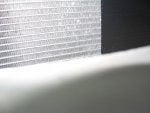rad heater photos
Gaspareau et al. Voici les photos. Here are the pics of the DIY rad blocker that you requested. I posted this project originally in this link, as reply #15...
http://www.jeeppatriot.com/forum/showthread.php?p=102350#post102350
Sorry for this delay, due to rainfalls (beaucoup!). Firstly, I got a small $7 sheet of black coroplast from an art store: 32" x 24". Coroplast is a plastic equivalent to ordinary corragated cardboard, and is used commonly for election signs; so it could be free; but I wanted black for inconspicous appearance. see
pic #1 (img_1029a.jpg)
Prep:
Cut out 3 pieces (panels), each 22" x 9.75":
pic #2 (img_1030a). Each panel can be installed by inserting it upward thru the center (largest) opening under the front bumper. This center opening is 9.75" wide x 2" giving a diagonal of 10.25". This diagonal is handy for easier insertion.
The openings on each side of the larger center opening is too small to use. You simply insert each panel thru the center opening, then slide the panel sideways, as needed
pic #2 (img_1030a) shows the 3 pieces near the locations, when installed. The center panel needs virtually no trimming. For the side panels, trim/notch upper corners to fit nicely around vent protrusions at the extreme top left & right corners of the rad; you'll see.
The bottom of each side panel need a slight trim, for levelling. The lower bumper goove where the panels sit on is slightly curved. I trim off a 0.5" skinny triangle. I also trimmed off some bottom corners to ease installment.
I cut a hole on each of the
side panels, to let in some air. Notice that the driver side panel hole still retain a flap, which could be closed manually. I can't gauge the right amount of cold air needed for now. The 2 holes is 10% of the area covered. So 90% of the rad area blocked.
Aside: As a WAI (Warm Air Intake) fan, I've removed the OEM airbox. I left the original air vent opening at the top driver corner of the rad alone. That's another fuel economy topic.
Note the location of the 2 air holes. The holes, when installed, are aligned behind the main thick bumper member. So that outside air and splashes will not enter thru the holes directly. Last winter with my late Ford, I found a layer of dried salt coating the rad blocker. So the bonus benefit of the rad blocker is to shield the engine compartment from grimy, salty splashes and blowing snow.
pic #3 (img_1031a) shows the ugly backside of the panels. To protect the coroplast from heat deformation, I glued some regular corrigated cardboard pieces onto the rad-side of the coroplast panel. The cardboard pieces acts as spacers that keep the coroplast from touching the hot rad metal.
I also placed/glued the cardboard pieces at strategic spots, to keep the 3 panels from shifting sideways from their intended position.
Also, note in
pic #2 (img_1030a) that the cardboard strips on the extreme outer edge of the side panels are glued 0.5" hanging out beyond the coroplast edge. So that the coroplast edge will not touch the metal side-frame of the rad.
pic #4 (img_1032a) shows the intended
overlapped positioning of the 3 panels when installed. I deliberately overlap the center panel to the side ones, so that the center panel cardboard spacer strips keep the neighboring side panels from shifting.
The lower bumper groove/lip piece slants inward, and may cause the coroplast panel to curl. So I glued wooden popsicle-sticks or tongue-depressors at the panel bottoms for rigidity.
btw. I initially cut a cardboard prototype to understand the fitting, trimming, notching and hole replacement. You may find doing a cardboard prototype useful.
pic #5 (img_1033a) tries to show how the panel sits on the lower bumper groove/lip.
Installation
1a/ Insert the panel for the passenger side of the rad thru the center opening. The panel should be flush against the rad. The panel top will be tuck between the rad and a black plastic valance-like trim. The panel bottom will just sit on the groove/lip of the lower bumper 'chin' piece. Go out and eyeball & finger the groove/lip which extends across the full width of the rad, just an couple inches below the rad bottom.
1b/ Just slide the panel sideways on the groove/lip, towards the passenger side of the rad.
2/ Insert the panel for driver's side, and slide to right. similar to steps 1a, 1b.
3/ Finally, insert the center panel. It will overlap the side panels a little bit. The strategically placed cardboard strips behind this center panel will keep the side panels from creeping sideways. I also used a small spring stationary clip (pic #2) on the lip/groove to double secure the bottom of the center panel.
btw. My Riot has stock everything: 16" steelies, no-lift. Nevertheless, I can now remove each panel in 20 seconds after a few practice runs; handy in an over-heating emergency at road side. Guys with 17" wheels or lift would have more ground clearance: even faster removal/install time!
For the month of October, I have installed only 2 of the panels, since the average outside temperature is above 5 C (40 F). No over-heating problem yet, in city & hwy trips. max rad temp 93 C (199 F). I plan go the full monty all 3 panel coverage when avg outside temp approaches freezing (0 C, 32 F).
Have fun, save some fuel money and keep the engine clean. This is version 2.5 of my blocker. I've been thinking and trying different prototypes since last winter. I hope this post will get you going a little faster.
Excusez moi for my English.

LOL.










